At first glance, a fillet knife and chef knife look somewhat similar. They are both long-bladed cooking and preparation knives, capable of a wide variety of tasks.
But what really are the differences between a fillet knife vs chef knife? And, more importantly, how do you know which is the correct blade for the job?
In this article, I’ll go over the main differences and the pros and cons of each. Both of these types of knives are invaluable to the kitchen cook or outdoorsman, so pay attention!
Fillet Knife vs Chef Knife: Differences
A fillet knife is a special-purpose knife designed exclusively for filleting fish or meat, while a chef knife is a multi-purpose knife designed for mincing, slicing, and chopping vegetables, fruits, and meat. A fillet knife is best for precision tasks, while a chef knife is best for general kitchen tasks.
Read on to learn more about what each can do for you, how they are different, and what key guidelines to keep in mind when purchasing.
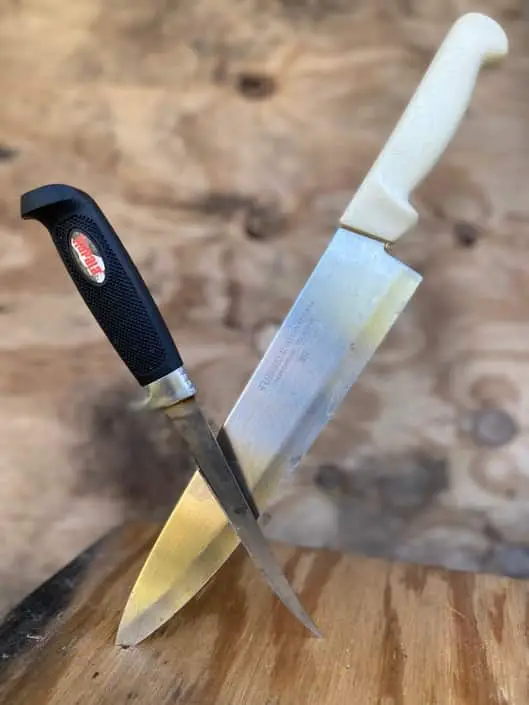
The main difference between a fillet knife and a chef knife is in their purpose. A fillet knife is specific-purpose, solely designed for filleting, while a chef knife is multi-purpose, which can be used for mincing, slicing, and chopping.
So, because of their purposes, they were designed to fit those functions. Fillet knives have long, narrower blades that curve at the end, termed as trailing point blades, to delicately separate meat from bones. Chef knives have also long but broader blades rounding at the tip, to perform most pre-cooking tasks.
What’s a Fillet Knife and How is it Used?
A fillet knife is, as the name indicates, used for filleting, or slicing a piece of meat or fish away from its bones. A fillet knife is a member of the boning knife family, specifically designed to give you good control while filleting, moving easily along the backbone and under meat skin.
Knife blades are usually 6 to 8 inches long, utilizing a trailing point blade (back edge curves upwards) for slicing or skinning. Generally, boning knives are heavier, more rigid, and best for separating meat from bones. Fillet knives are lighter, more flexible, and best for filleting fish.
When filleting, the blade is drawn towards the knife user in a sweeping manner, cleanly separating the skin or meat from the game or fish. First, you identify where the main bone is. Then use the edge of the knife to slice around the bone. When done right, the meat should come off in one piece.
Pro Tip: Try using a fillet knife the next time you need to remove the backstrap from a deer or elk! The flexible blade works very well at bending around the rib bones and awkward angles.
What’s a Chef Knife and How is it Used?
A chef’s knife is one of the most versatile knives to have, in your kitchen or outdoors. Usually around 6 to 14 inches in length with the blade rounding at the tip, a chef knife has a broad and sharp blade, which will help you in a variety of pre-cooking tasks like fast cutting meat, dicing vegetables, slicing herbs, chopping nuts, and disjointing some cuts.
When chopping, which is the most common function of a chef knife, hold the knife along the middle of the blade, not at the handle, which can be more dangerous. Balance the knife on your hand. Your four fingers should be on one side and your thumb on the other side of the blade.
When chopping with one hand, steady the tip of the knife with the other hand, rocking it back and forth, to get the most out of your chopping.
Fillet Knife vs. Chef Knife: Pros
Hunters and fishermen love the trailing point feature of the fillet knife and the large, curved cutting area of the blades — or “belly”, they call it — because fillet knives are exclusively designed for skinning or slicing meat away from bones to precision.
A good chef’s knife is also called the “do-it-all” knife as it can be used for a variety of pre-cooking tasks like mincing, slicing, and chopping vegetables, meat, and fish, and can be handy when you’re out in the woods camping.
Note, a chef’s knife is not to be confused with an EDC knife…its just too big to carry in a pocket or pack.
Fillet Knife vs. Chef’s Knife: Cons
Fillet knives’ trailing point blades are weak when used on tougher materials since they are specifically designed for fine and delicate work. They will easily bend or break when used for other purposes.
They are also difficult to place in knife sheaths along with other knives because the tip has to be carefully guided and rolled into the sheath, so it’s recommended to store it in the sheaths they came in, or in a plastic box with long slots and no cross-tabs, or a knife roll.
Chef knives are not ideal for precision tasks like peeling, fine mincing, and slicing bread, or tougher tasks like carving dense meat, cleaving meat bones, and disjointing bigger cuts.
Although a chef knife can generally cut meats, it is not very helpful if you want long, large cuts due to its shorter blade. Butcher’s knives are more appropriate for longer, thicker cuts.
Knife Buying Tips
In choosing fillet knives to buy, you will find that they come in different standard blade sizes: 4, 6, 7.5, and 9 inches. The variance depends on the size of fish (or game) you will use them for. Bigger fish require a longer blade for the wide girth and larger surface area you will deal with. Smaller fish need a shorter blade for easier handling.
A 6-inch fillet knife is best for panfish (bluegills, crappie, perch) while a 9-inch blade is best for pike, salmon, and other large fish, although a 7.5-incher can be an “all-around” fillet knife.
Consider also the material the blades they’re made of: ideally, they should be stainless steel, but not all stainless steel knives are equal so choose one from a reputable company (this goes for the chef knife, too).
You May Also Like: Are Expensive Pocket Knives Really Worth It?
Check for the fillet knife’s flex: the tip should bend an inch or more either way when it is pressed straight down and pressure is applied. The handle should provide comfort, grip, and execution support (plastic and molded rubber are better than wood). The handle should also have a beveled area where the blade meets the handle for your index finger to rest on, providing more leverage and insurance against slipping.
Since a chef knife is multi-purpose, you would be using it more often. Look for a chef knife that’s comfortable when you hold it in your hand, feeling solid and not lightweight and flimsy, as you mimic the motions of slicing and chopping.
An 8-inch French chef knife is recommended for chopping herbs, small fruits, and vegetables, while a 10-inch serrated chef knife is best for cutting large food, from cantaloupes and watermelons to game.
Conclusion
I do a lot of fishing, so a fillet knife is an indispensable tool when cleaning fish. However, I love to hunt too- and when I’m preparing cuts of venison my go-to is a chef’s knife.
Each style of knife has its pros and cons, and one is not better than the other. I hope this article helps, and thank you for reading!
You May Also Like: Why Do Some Knives Have Holes In The Blade Or Handle?
- Neem Oil Deer Repellent: Does It Really Work?

- Is It Okay To Burn Bark In a Wood Stove?
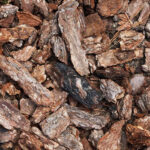
- Do Deer Eat Morel Mushrooms?

- How To Properly Dispose of Wood Stove Ashes (Safely!)
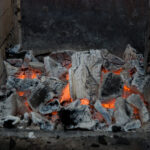
- Is Fatwood Safe for Wood Stoves? Here’s What You Should Know
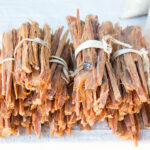
- Is Beaver Good to Eat? You May Be Surprised!
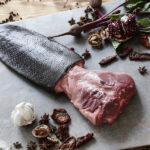
- Is Bread Bad For Deer? Here’s What You Should Know

- Are Roosters Good to Eat?
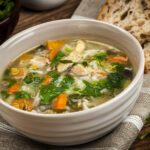
- 3 Easy Ways To Tell If Your Wood Stove Is Leaking
